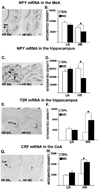Vulnerability to nicotine abstinence-related social anxiety-like behavior: molecular correlates in neuropeptide Y, Y2 receptor and corticotropin releasing factor
- PMID: 21195134
- PMCID: PMC3038185
- DOI: 10.1016/j.neulet.2010.12.056
Vulnerability to nicotine abstinence-related social anxiety-like behavior: molecular correlates in neuropeptide Y, Y2 receptor and corticotropin releasing factor
Abstract
An outbred rat model of the novelty-seeking phenotype is used to study nicotine vulnerability, where experimentally naïve rats were phenotype screened as high or low responders (HRs or LRs, ranking in the upper or lower one-third of the population respectively) based on locomotor activity displayed in a novel environment. Following nicotine training and abstinence, HR animals pre-trained with nicotine showed expression of locomotor sensitization to nicotine challenge along with enhanced social anxiety-like behavior in the social interaction test compared to saline pre-trained controls. HR rats also showed a downregulation in neuropeptide Y (NPY) mRNA levels in the medial nucleus of amygdala and the CA1 field of the hippocampus, an upregulation in Y2 mRNA levels in the CA3 field of the hippocampus, and an upregulation in the corticotropin releasing factor (CRF) mRNA levels in the central nucleus of the amygdala. These findings implicate dysregulations in the NPY-CRF systems in the HR hippocampus and amygdala associated with the emergence of social anxiety-like behavior, and a novel Y2R-mediated pathway in nicotine relapse.
Published by Elsevier Ireland Ltd.
Figures


References
-
- Bhatti AS, Hall P, Tao R, Isgor C. Hippocampus modulates the behaviorally-sensitizing effects of nicotine in a rat model of novelty-seeking: potential role for mossy fibers. Hippocampus. 2007;17:922–933. - PubMed
-
- Bhatti AS, Aydin C, Oztan O, Ma Z, Hall P, Tao R, Isgor C. Effects of a cannabinoid receptor (CB) 1 antagonist AM251 on behavioral sensitization to nicotine in a rat model of novelty-seeking behavior: correlation with hippocampal 5HT. Psychopharmacology (Berl) 2009;203:23–32. - PubMed
-
- Bjijou Y, De Deurwaerdere P, Spampinato U, Stinus L, Cador M. D-amphetamine-induced behavioral sensitization: effects of lesioning dopaminergic terminals in the medial prefrontal cortex, amygdala and the entorhinal cortex. Neuroscience. 2002;109:499–516. - PubMed
-
- Bura SA, Burokas A, Martín-García E, Maldonado R. Effects of chronic nicotine on food intake and anxiety-like behaviour in CB(1) knockout mice. Eur Neuropsychopharmacol. 2010;6:369–378. - PubMed
-
- Barsy B, Leveleki C, Zelena D, Haller J. The context specificity of anxiety responses induced by chronic psychosocial stress in rats: a shift from anxiety to social phobia? Stress. 2010;13:230–237. - PubMed
Publication types
MeSH terms
Substances
Grants and funding
LinkOut - more resources
Full Text Sources
Medical
Miscellaneous

